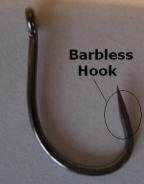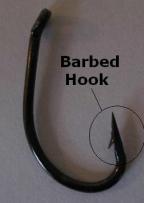Carp fishing is quite the rush simply due to the sheer size of these fish. They are HUGE! So how do you get your hands on a carp? Read on!
Let’s look at the basics of carp hooks

Barbed or Barbless Carp Hooks?
The first decision is to establish whether to use barb or barbless hooks. For some carp anglers the decision will be made for them because many fisheries won’t allow the use of barbed hooks. If you have a choice I would say use barbed whenever possible.
Many of the carp in pressured waters have learned intricate ways of ejecting rigs to evade capture. A barbless carp hook makes the process of ejection easy for many of the wily carp. During a session our hook bait will frequently be picked up by a fish and the hook will prick the fish’s mouth. When this occurs a carp will often shake it’s head vigorously and the weight of the attached bait flicking from side to side can help lever the hook point back out of the flesh and lose grip.
The carp now blows and the rig is ejected. All this can happen within seconds and often without a sound from the alarm, no matter how sensitive the setting. This process can be seen clearly in the Korda underwater videos.

With a barbed hook you only need the hook to penetrate to the barb and the carp will rarely be able to eject the rig, eventually they’ll move off and cause the alarm to buzz. I always use barbed hooks whenever possible, although for most situations I prefer the whisker barbs as these also limit the damage to the carps mouth during the fight.
Hook Sharpness – A word of warning about the sharpness of carp hooks
One of the most important things to remember about hooks is to make sure they always remain sharp. A sharp hook will drive into the flesh easier allowing the barb to penetrate and give a strong hold quicker. A blunt hook may not penetrate enough and allow the fish to blow the rig back out. Also, a slight flat spot on the hook point will cause a bigger hole when it pricks the carp’s mouth. When this happens the hook has no grip and will simply fall out of the flesh with any slack line, it may even fall out under the weight of the hook or bait. Remember, a sharper hook means faster penetration. (There’s a joke in there somewhere!)
A test for hook sharpness.
I like my hooks to be sticky-sharp, this is where the hook tends to stick in my hand when testing how quickly it turns on the rig. I find that using a hook sharpener causes the hook to lose that slight stickiness, don’t know why, maybe it’s due to losing the outer coating near the point of the hook during sharpening. For this reason I don’t use a hook sharpener unless it’s for one cast while creating a new rig.
Hook Wire Thickness
Carp hooks come in varying sizes and hook patterns. A general rule is that, the bigger the hook size the thicker the wire will be. I believe in some situations the wire thickness can make a difference between hooking and missing a fish. The thicker the hooks wire, the more force it will need for the barb to reach the flesh and grip. The problem here is that many big carp won’t move with force, they are often cautious when feeding on baits and will take the bait gently. If they sense danger then they can try to eject the bait. With a thin hook wire the barb stands a much better chance of reaching the flesh even when cautious carp are feeding.
There is another benefit to using a thin wired hook – WEIGHT. Some carp feed by sucking up baits from a few inches away. They will suck at groups of loose feed and obviously the lighter, smaller baits will enter the mouth first. Bait that is tethered to a heavy hook will make it harder for it to enter the carp’s mouth as the hooks weight pulls it back to the lake bed. A lighter hook will help to avoid this happening.
I always try to use the smallest hook I can get away with, especially during the day when light levels are high. I sometimes change to a bigger hook at night but this often requires the use of buoyant baits to help counteract the extra weight of the thicker wire.
All credit for these awesome tips goes to Carp Fishing Tactics. http://www.carp-fishing-tactics.com/carp-hooks.html





